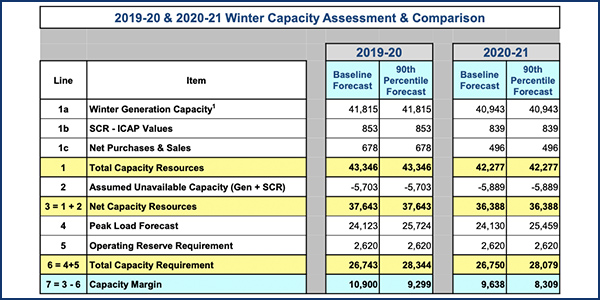NYISO CEO Richard Dewey informed the Management Committee on Wednesday that the ISO’s Board of Directors met Nov. 17 and approved the 2021 budget, 2020 Reliability Needs Assessment (RNA), and the parameters, methodologies and assumptions for the 2021-2025 capacity market demand curve reset.
“I’m not at liberty to disclose the details of demand curve reset decision at this time, but that will become public Nov. 30 when we make the filing with FERC,” Dewey said.
The MC in October had endorsed a technical fix to the 2017-2021 reset to address an error in the model used to estimate net energy and ancillary services revenues for a hypothetical peaking plant. (See “Fix Endorsed on Demand Curve Reset,” NYISO Management Committee Briefs: Oct. 28, 2020.)
In addition, the current surge in COVID-19 cases throughout much of the country has prompted the ISO to extend remote working until at least April 1, 2021, Dewey said. Given the impossibility of the ISO holding its annual appreciation dinner, Dewey closed by lauding the productivity and value of the stakeholder process, and publicly thanking the chairs and vice chairs of the various committees and working groups.
The committee also approved officer certification changes, hybrid storage facilities, meter services, and pricing of fast-start resources and ancillary services, as endorsed by the Business Issues Committee. (See NYISO OKs Changes on Hybrid, Fast Start Resources, TCCs.)
Winter Capacity, Preparedness Look Good
The 2020-2021 Winter Capacity Assessment showed that for projected baseline forecast peak conditions and expected performance of the transmission system, generation and pipeline infrastructure, NYISO expects to meet reliability criteria throughout the coming winter.
The ISO’s base-case analysis projected a 9,638-MW capacity margin for 50/50 peak winter conditions and a 8,309-MW capacity margin for 90/10 peak winter conditions.
“It’s not completely surprising that we have these large capacity surpluses; we’re still a summer-peaking system,” Vice President of Operations Wes Yeomans said. “The winter peak load forecast numbers have been pretty flat for the past five to seven years but will likely be rising with the expected increase in electrification in New York.”
Subtracting gas-only units with interruptible supply while retaining only units with firm gas supplies, the margins drop “significantly” to a 3,118-MW margin for 90/10 conditions, Yeomans noted.
Significant changes compared to last year include the additions of the 1,177-MW Cricket Valley Energy Center and the 126-MW Cassadaga Wind project, and the retirements of the 1,299-MW Indian Point 2, 655-MW Somerset, 52-MW West Babylon 4 and 169 MW in dependable maximum net capability adjustments, he said.
Continuing forced transmission outages include the 345-kV “B” and “C” lines between New York City and New Jersey, and the 230-kV Moses-Adirondack lines being rebuilt by the New York Power Authority, which can be brought back online within 48 hours.
Seasonal generator fuel surveys show that oil-burning units have sufficient start-of-winter inventories and arrangements for replacement fuel, Yeomans said.
NYISO has coordinated with many generating stations, “remotely this year due to COVID-19,” to discuss past winter operations and preparations for upcoming winter, including generation testing, preventative maintenance, fuel capabilities and fuel-switching capabilities, he said.
The ISO also participated in winter preparation efforts with NERC, state agencies, other ISOs/RTOs and gas industry personnel, and 96% of the respondents to the annual Generator Fuel and Emissions Reporting survey indicated precautionary measures are in place for the upcoming winter.
Regarding gas-electric coordination, a communications protocol is in place with state agencies to improve the speed and efficiency of generator requests to state agencies for emissions waivers if needed for reliability. “We’ve used it a couple times, and it’s worked very well,” Yeomans said.



